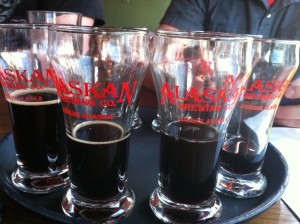
As part of Madison Beer Week, the Tipsy Cow had a vertical tasting of Alaskan Smoked Porter spanning over 16 years! The oldest bottle was from 1996, followed by an eight year break to 2004, finishing in 4 year increments with 2008 and 2012. Alaskan Smoked Porter falls under the category of a traditional German Rauchbier, which is slowly starting to gain some traction in the American market. In order to impart the smoked flavoring, Alaskan Brewery selects portions of the 5 malts that make up this beer and put them into a commercial food smoker. They use local alder wood to smoke the malts prior to them entering the mash.
There are a couple factors that allow this beer to be aged an uncharacteristically long time. First and foremost, smoke has been used as a natural preservative for centuries and the preservative nature of smoke carries over to the brewing process. Secondly, this beer is unpasteurized and bottle conditioned. What that means is that live yeast are put into each bottle, which will consume any leftover sugar and oxygen in the bottle when it is sealed, thus eliminating two factors that could cause the beer to age prematurely. The beer can’t go through the pasteurization process or it would kill the live yeast cells that are doing critical work to age this beer to perfection.
Onto the tasting
2012 – I had a year old version of this beer last year and enjoyed it quite a bit. Unfortunately, when you taste it next to the aged varieties it just doesn’t match up. It is very noticeable how the flavors have not blended together after a year and the beer feels disjointed. The smokiness is present at first before giving way to an off flavor that has an almost “lagery” characteristic. Finally, the smoke comes back in force at the end. A great beer, but the flaws are much more noticeable in a vertical setting.
2008 – I was pretty shocked to discover the 5 year old version was by far the most mellow of the bunch. Smoke in the nose, but the mouth was smooth and mellow. You get a really good feel for the malts that go into the beer as some sweetness shines through. The smokiness creeps back in much later than expected to round out this beer. By far the least smoky, but also the most interesting of all the versions because your palate is truly on a journey.
2004 – If I could make a guess, this is the exact beer the brewers were trying to create when they made this beer. The smokiness has raged back and really carries well throughout the entire mouth. Nose to front to back, this is the most balanced and consistent version of all. The smoke was definitely the star of this beer, but it didn’t overwhelm the maltiness either and was variable throughout the mouth. I wish I had more to say about the 2004 because it was my favorite of the bunch, but I always preach for balance in beer and this one really accomplished that to perfection.
1996 – It is important to note that there was an 8 year break in the vertical so some of the differences were magnified. Let’s face it, holding a solid carb on a beer for 17 years is a truly amazing feat, but this was the least carbonated of all the varieties. I think this played a pretty important factor in the flavor of the beer. With less carb, the beer will coat your mouth and tongue more so you get a more one dimensional taste of the beer with less contribution in the nose and mouth feel. As I alluded to, the smoke on this one coats the palate rather than letting be a presence throughout the mouth. It is also important to note that most of the flavors in this beer are going to fade in 17 years, while the smoke continues to hold strong. So I wouldn’t necessarily say the smoke flavor intensified, but rather other flavors that balanced or distracted have faded away.
Conclusions
I was extremely shocked how subtle the differences were over a 16 year span. Our group of four felt, as a consensus, that the 2004 variety was the best. We were split 2-2 as to which our second favorite variety was between 1996 and 2008. Everyone agreed that 1 year on this beer really wasn’t enough after tasting how the beer came together over multiple years. If you are going to cellar some bottles of Alaskan Smoked Porter, I feel that the 8-10 year timeframe is likely ideal for hitting this beer at its peak. If you prefer less smokiness, try somewhere in the 4-5 year range when those flavors are the most mellow.